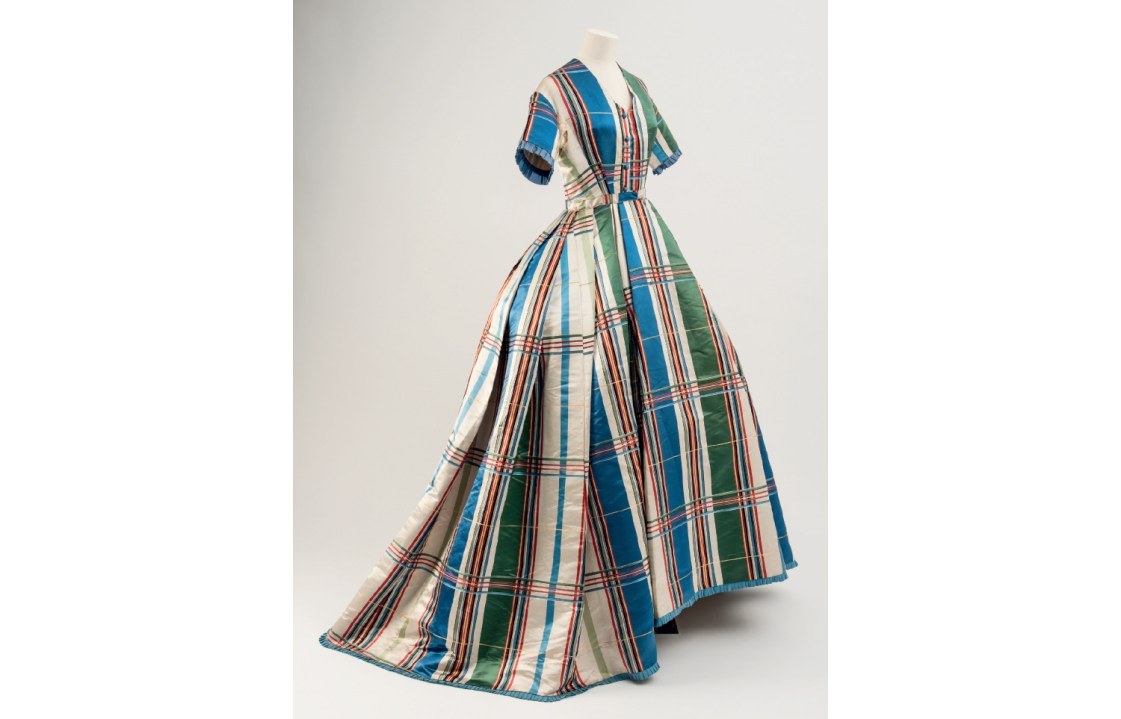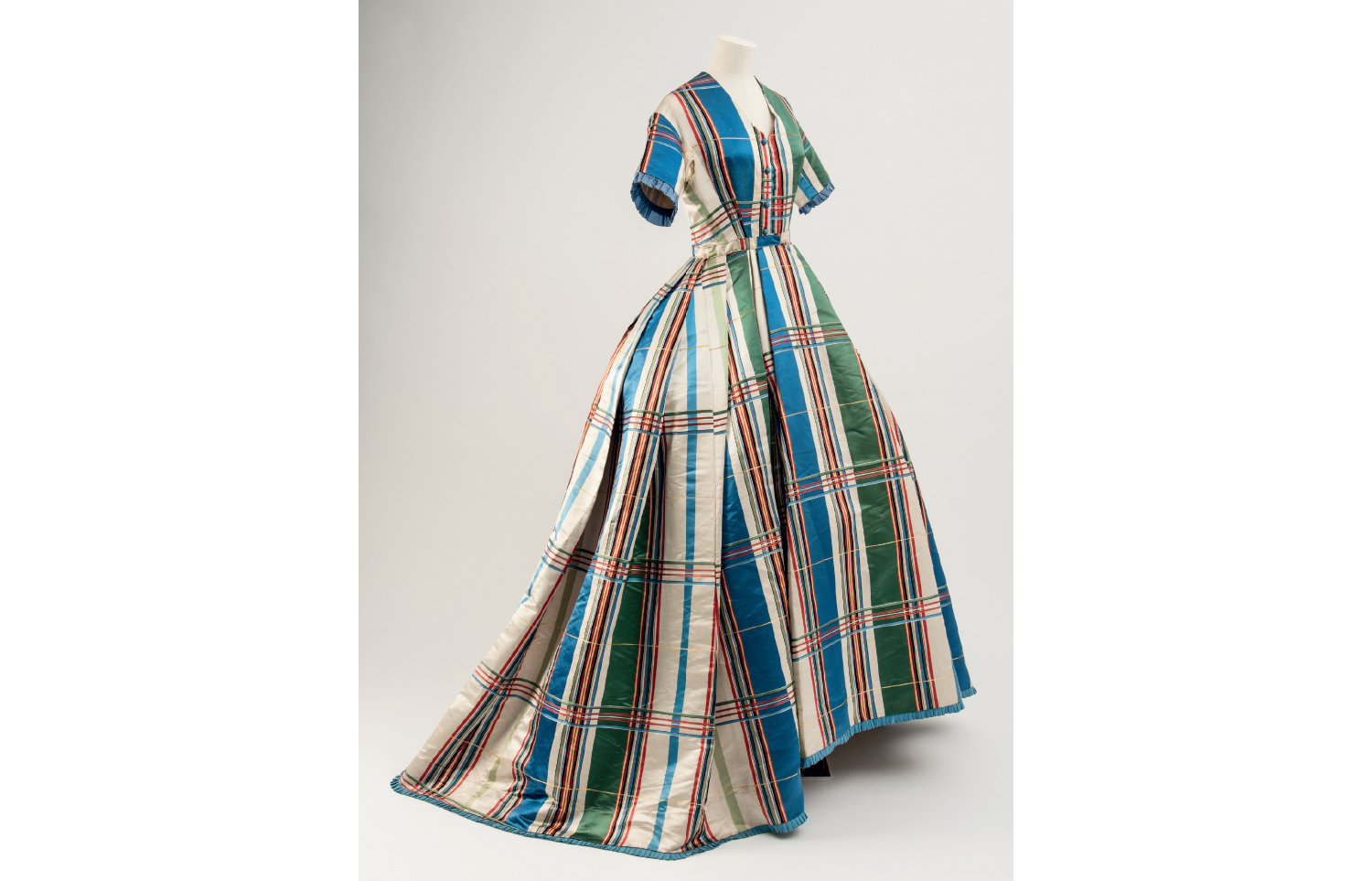Criss-crosses, everywhere: 300 objects covered in them. The exhausting range and depth of the world’s most famous pattern is on full display at the V&A Dundee’s vast new exhibition.
Tartan is a more genuine emblem of Scottish nationhood than the famous deep-fried Mars bar, which no one really eats. But it’s not uniquely Scottish. Plaid has been worn across western Europe for hundreds of years, then was claimed by Scotland as the symbol of the nation, now recognised the world over. It’s even a political weapon. In the recent SNP leadership election, the outsider Ash Regan wore practically nothing but the fabric. Ian Blackford has in the past unnerved many a viewer when he bent down in his kilt to lay a wreath at the Cenotaph. And Nicola Sturgeon even wore a tartan face mask during the pandemic.
I saw a tartan teapot, a tartan guitar, a stuffed tartan crocodile, a tartan Xbox controller
At the V&A, I saw a tartan teapot, a tartan guitar, a stuffed tartan crocodile, a tartan Xbox controller. One of the best items is Scotland’s oldest tartan, the Glen Affric, found in a peat bog in the Highlands four decades ago. Radiocarbon testing has dated it between 1500 and 1655. The wetlands have preserved it remarkably well.
Tartan is highly regulated. There exists a Scottish Register of Tartans, a government-sponsored department launched in 2009. In the exhibition’s first room, we are immediately told the rules of ‘the grid’. Tartan has to be a minimum of two colours, producing a third where they meet. The pattern formed by the warp and weft is called a ‘sett’. Everything has to be in perfect balance. It’s slightly officious and intimidating. I’d always believed that identifying a tartan pattern was more akin to Kenneth Clark’s maxim in Civilisation: I know it when I see it.
The most revealing item in the show is the Vestiarium Scotium (1842). For a few years, this was thought to be the tartan bible, showing which Highland clan wore which pattern. But it’s now thought to be a forgery. John and Charles Allen, otherwise known as the ‘Sobieski Stuarts’ due to their supposed relation to the Jacobite monarchs, claimed that they had discovered medieval manuscripts showing that tartan was worn by both highlanders and lowlanders. Contemporaries smelled a rat, including Sir Walter Scott, and after a little digging they proved that the Vestiarium was a tartan-weavers’ ruse.
As Hugh Trevor-Roper wrote in The Invention of Scotland, the Sobieski Stuarts were classic up-from-Englanders, granting Scottish history an order that it lacked. There was a decent case to be made that Highland life really was just barbarous, argued Trevor-Roper, and that it was only after roads and a legal system came that ‘soft-headed modern writers could invest that barbarism with retrospective romance’.
Tartan is, whether out loud or not, about Scotland claiming ownership of the fabric. But the exhibition should admit that the oldest known tartan cloth is actually about 2,500 years old and was found not in Scotland but in north-west China; and that Boudica dressed in a ‘tunic of many colours’, according to Dio Cassius, that most people have interpreted to be a tartan check. Why hasn’t the pattern become a political weapon in Beijing or Westminster? How did tartan acquire its status in Scotland? And why did it happen only recently? Even Scottish football fans didn’t start getting tartaned up until the 1970s.
But instead of taking a genuine look at the emergence and invention of this artistic tradition, the exhibition has a section on ‘tartan and sexuality’, focusing on the historic ‘fascination’ with what lies under the kilt (I think we can guess). The show is keen to promote the idea that tartan is ‘rebellion’, and asserts that tartan ‘can inspire new understandings of masculinities, promote awareness of sexual discrimination and question fixed sexual identities’. Is that not true of all clothes?
Overlooked by the curators is what a conservative object tartan is: a fixed motif connecting the living and the dead. A design that valorises blood and family. The show wants to emphasise how the pattern can liberate the individual, but fundamentally tartan represents the complete opposite: it’s about subsuming personhood within a group.
Tartan’s modern revival owes much to the romantic revisionism of the Jacobite rebellion by George IV, whose visit to Scotland in 1822 – the first by a reigning monarch in nearly two centuries – was carefully choreographed by Walter Scott. It’s been deftly and very successfully marketed ever since by Scotland’s most famous sons and daughters. The tam o’shanter written about by Robert Burns is here. Alan Cumming is shown wearing a kilt during the ‘Yes’ campaign for independence in 2014. And Jackie Stewart’s tartan racing helmet is the last exhibit, which is a relief because a mannequin wearing a tartan face mask threatened to be the cringe-worthy finale.
Is Scotland the best place for a tartan show? Would Paris be the best place for a dive into berets? Would a vodka exhibition do well in Moscow? The Guinness factory in Dublin is considered a tourist trap. It’s a surprise that Tartan, the V&A Dundee’s first in-house curated exhibition, hasn’t been more mocked. It’s not far off choosing haggis or whisky or bagpipes.
The show reflects a wider desire, across all the arts, for us to look inward. For self-examination. To shirk the unfamiliar and foreign. Art today must be relatable. Like so many museums, the V&A Dundee is asking ‘who are we?’ instead of ‘who are they?’ If this exhibition is an exercise in nation-building, that’s fine, but would a truly self-confident culture need to do this?
And why Dundee? The V&A opened here in 2018, the centrepiece of a £1.6 billion regeneration. Being the butt of Scottish jokes will make a city want to do that. It has been seen as a place of Hogarthian poverty. The Scottish Advocate General Lord Cockburn said in 1844 that Dundee was a ‘sink of atrocity which no moral flushing seems capable of cleansing’. Ironically, that was during Dundee’s finest hour, when it expanded thanks to the jute industry and trade with the Empire.
Is Scotland the best place for a tartan show? Would Paris be the best place for a dive into berets?
Some will say the decline started with the planning decisions of the 1960s city council who instead of restoring the magnificent old buildings chose to replace them with concrete slabs. The new waterfront is pleasant enough, but it is the duff architecture of Hotel Ibis, New Labour and ‘hubs’.
The V&A in London sold itself in the 1980s as an ‘ace caff, with quite a nice museum attached’, and the Dundee branch is too (it does a great cheese toastie). But it is meant to be more than an art gallery or an ace café: there is an expectation that it will spur the city to better things. Achieving that would make it a GCSE geography case-study par excellence. Turning a city’s fortunes around solely through art has been tried many more times than it’s succeeded.
Far easier, however, for Scotland’s leaders to say that the V&A will make Dundee a nicer place to live than to try to solve its real problems. A city where more people are dying of drugs than anywhere else in Europe; where people are more likely to be the victim of violent crime than anywhere else in Scotland; where half of baby boys are expected to die before they reach the age of 73; where teenage pregnancies are the third highest in the country; where more women are victims of domestic violence than in any other Scottish city.
While I was there, Dundee’s ambient darkness was made only more eerie by the curated absence of it at the waterfront. The city needs help – proper help. A tartan plaster won’t heal the wound.
Tartan is at V&A Dundee until 14 January 2024.








Comments